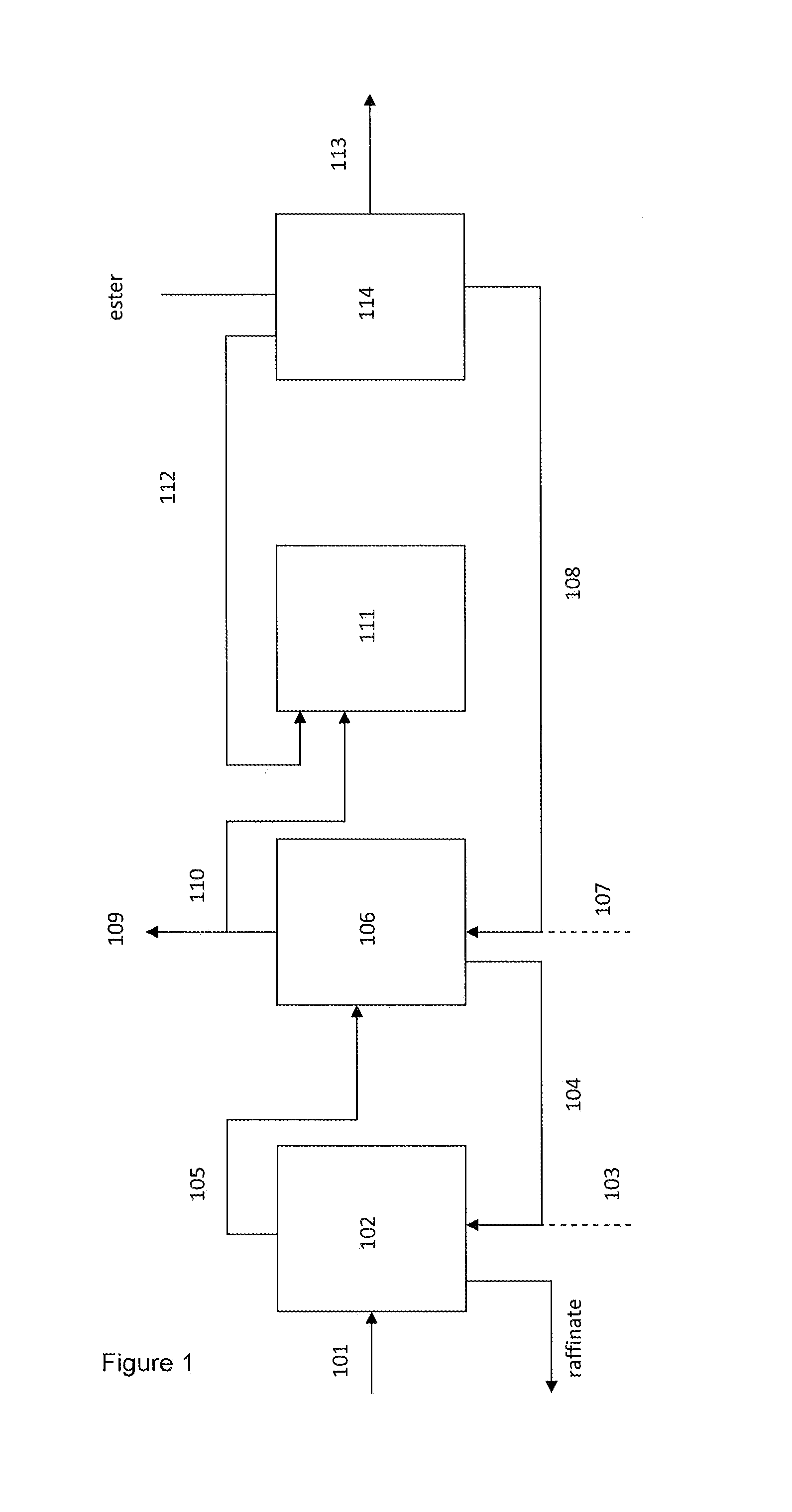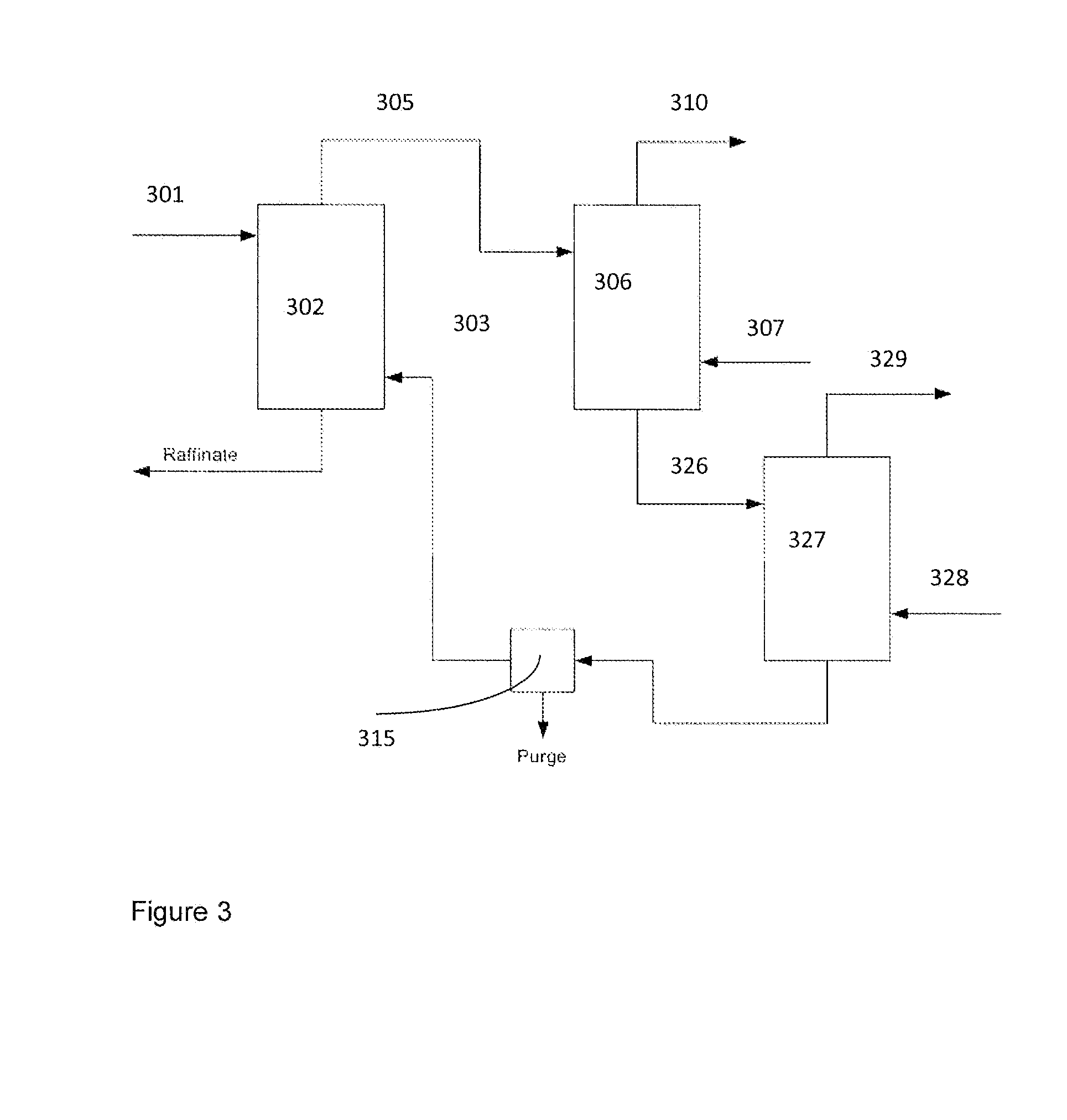Method for recovery of organic acid from dilute aqueous solution
a technology of organic acid and dilute aqueous solution, which is applied in the separation/purification of carboxylic acid esters, carboxylic compound preparations, and carboxylic acid esters. it can solve the problem that esterification has not been used as a technique to efficiently liberate, and achieves efficient removal of acids. , the effect of high carboxylic acid yield
- Summary
- Abstract
- Description
- Claims
- Application Information
AI Technical Summary
Benefits of technology
Problems solved by technology
Method used
Image
Examples
example 1
[0068]Boiling points of selected water soluble C1-C5 carboxylic acids in the form of free acids and methyl esters are depicted in table 1 for pure compounds. The boiling point interval within the mixture in the form of free acids under atmospheric pressure is 84° C., and respectively in the form of methyl esters 95° C. indicating larger separation available for the latter set. The acid recovery in the form of esters is achieved both at lower temperature and with a better separation compared to recovery in the form of free acids even if no complexing with the extractant takes place.
[0069]This is an evidence that it is clearly energetically more favourable to recove the acids as esters compared to recovery in acid form.
TABLE 1Boiling pointBoiling pointat 1 atm asat 1 atm asAcidfree acidmethyl esterformic acid10133acetic acid11758propionic acid14179butyric acid162103valeric acid185128
examples 2-5
[0070]Extraction
[0071]A Scheibel column was filled with an aqueous solution containing 3.5 wt-% formic acid (Kemira) from the top of the column at the rate of 3.93 kg / h. Cyanex 932 (Cytec) solution was fed to the bottom of the column at the rate of 0.998 kg / h. Agitation speed was 350 rpm and the temperature of the column was in the range of 25-28° C. Extraction solution was separated and taken out of the column at the rate of 1.08 kg / h. It contained 9.9 wt-% formic acid (calculated as pure) and 3.4 wt-% water in Cyanex 923. The recovery yield of formic acid in Cyanex 923 was 78%.
[0072]Esterification
[0073]500.23 g of the obtained extraction solution was mixed with 105.73 g of methanol in a glass reactor heated with circulating silicone oil. The reactor was equipped with a fractionating distillation column containing structured packing and a cooler, cooled with isopropyl alcohol. The solution was warmed up to 70° C. with continuous mixing under ambient pressure. Distillates comprising...
example 3
[0080]Extraction
[0081]Extraction was carried out similarly to example 2.
[0082]Extraction solution taken out of the column contained 9.0 wt-% formic acid (calculated as pure) and 3.1 wt-% water in Cyanex 923.
[0083]Esterification
[0084]500.00 g of the obtained extraction solution was mixed with 96.0 g of methanol similarly to example 2. The solution was warmed up to 90° C. with continuous mixing under ambient pressure. Distillates comprising methyl formate in methanol were collected and more methanol was stepwise introduced into the reactor below the liquid surface level. The solution was kept at about 90° C. and the distillation was continued as long as distillate was obtained.
[0085]The consumption of methanol was recorded and methyl formate formation was quantified from distillates and from the distillation bottom with GC. Table 4 shows the uniform quality of the distillate and table 5 shows the final outcome.
TABLE 4BottomDistillateMethyltemperatureTop temperaturecollectedformateMeth...
PUM
| Property | Measurement | Unit |
|---|---|---|
| concentration | aaaaa | aaaaa |
| temperature | aaaaa | aaaaa |
| pressure | aaaaa | aaaaa |
Abstract
Description
Claims
Application Information
 Login to View More
Login to View More - R&D
- Intellectual Property
- Life Sciences
- Materials
- Tech Scout
- Unparalleled Data Quality
- Higher Quality Content
- 60% Fewer Hallucinations
Browse by: Latest US Patents, China's latest patents, Technical Efficacy Thesaurus, Application Domain, Technology Topic, Popular Technical Reports.
© 2025 PatSnap. All rights reserved.Legal|Privacy policy|Modern Slavery Act Transparency Statement|Sitemap|About US| Contact US: help@patsnap.com



